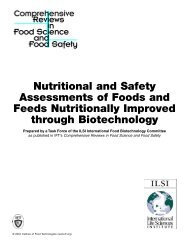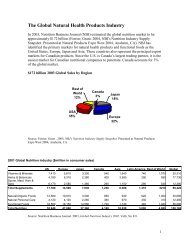Beyond Borders: Global biotechnology report 2010
Beyond Borders: Global biotechnology report 2010
Beyond Borders: Global biotechnology report 2010
Create successful ePaper yourself
Turn your PDF publications into a flip-book with our unique Google optimized e-Paper software.
of today’s increasingly pragmatic industry.<br />
For example, Comvita, a biotech business<br />
created to exploit the health benefits of<br />
manuka honey, is continually researching<br />
and bringing new products to market.<br />
Partnerships and alliances<br />
Many New Zealand <strong>biotechnology</strong><br />
companies partner and share information<br />
with other local and foreign organizations<br />
for product, process development or<br />
research. Aquaflow Bionomic Corporation<br />
is working with US-based Honeywell to<br />
develop technology that enables the<br />
harvesting and refining of wild algae to<br />
create biofuels (For more on biofuels,<br />
see the roundtable article “Embracing the<br />
future” on page 98). Other applications of<br />
the innovative technology, such as carbon<br />
sequestration, are also being explored.<br />
The growing trend of partnering is gathering<br />
momentum, particularly with universities<br />
and research institutions. The University<br />
of Auckland Institute for Innovation in<br />
Biotechnology — built in 2009 and the<br />
first such incubator in New Zealand<br />
brings together academics and industry<br />
partners from biotech and pharma in one<br />
location. Partners draw on the expertise<br />
of internationally recognized academics<br />
through collaborations or contract research.<br />
The Government-supported institute aims to<br />
increase collaboration between universities<br />
and industry, lower entry barriers for<br />
newcomers and advance New Zealand’s<br />
<strong>biotechnology</strong> workforce. A number of<br />
venture-backed businesses are already<br />
based in the institute or planning to set up<br />
operations, including CoDa Therapeutics and<br />
Androgenix.<br />
Government support<br />
A new Government was elected in 2008,<br />
and despite eliminating the R&D tax credit,<br />
it maintains a significant focus on innovation<br />
and <strong>biotechnology</strong>. The challenge is to<br />
identify ways to improve the effectiveness of<br />
ongoing investment in science, technology<br />
and innovation, particularly biosciences.<br />
In encouraging development, the<br />
Government not only gave Living Cell<br />
Technologies (LCT) approval to enter<br />
Phase II trials of DIABECELL-encapsulated<br />
porcine islets for treating insulin-dependent<br />
diabetes, but also provided NZ$7.8 million<br />
(US$5 million) in grants to the company to<br />
fund the clinical trials. Interestingly, LCT<br />
has also licensed its patented encapsulated<br />
technology to non-competing partners to<br />
help fund ongoing trials.<br />
In March <strong>2010</strong>, a Government-appointed<br />
taskforce issued recommendations<br />
for improving the performance of the<br />
Government-funded Crown Research<br />
Institutes (CRIs). The <strong>report</strong> recommended<br />
significant changes to the way CRIs are<br />
operated to provide greater funding<br />
certainty for long-term projects. It also<br />
included measures to encourage technology<br />
transfer and boost spin-offs of businesses<br />
from CRIs, particularly in health care,<br />
agricultural biotech and food technology.<br />
Outlook<br />
While the Government interest in the<br />
industry is a positive step, the growth<br />
of New Zealand <strong>biotechnology</strong> will also<br />
be driven by better offshore product<br />
marketing, growth in sectors such as<br />
biofuels and foods, and the ability to serve<br />
the needs of other emerging markets.<br />
46 <strong>Beyond</strong> borders <strong>Global</strong> <strong>biotechnology</strong> <strong>report</strong> <strong>2010</strong><br />
For example, China — a country that has<br />
been actively investing in New Zealand<br />
agriculture — is showing an interest in New<br />
Zealand biotech, attracted by the country’s<br />
high standards of education and strong<br />
product/food safety systems.<br />
New Zealand biotech companies are taking<br />
a fresh look at business models, deal<br />
structures, financing, partnering and joint<br />
ventures. They are looking for investors<br />
to develop their products further and<br />
provide market entry into Europe and the<br />
US. They are also working to get products<br />
to market sooner. Many pipeline products<br />
are at a stage in the life cycle where they<br />
can be licensed to offshore organizations<br />
to create a revenue stream to fund further<br />
R&D. Continued growth will depend on<br />
companies’ abilities to follow through on<br />
these creative and pragmatic solutions.








